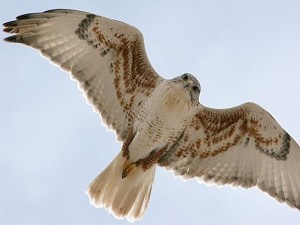This is the fourth in a series of posts on birds at risk in Canada. The Committee on the Status of Endangered Wildlife in Canada (COSEWIC) lists 73 bird species as endangered, threatened or of special concern.

Ferruginous Hawk (Buteo regalis) is listed as Threatened in Canada. Photo by Steve Metz
Ferruginous hawks are the largest broad-winged soaring (buteo) hawks in North America, and true symbols of the open prairies. These large birds average 23 inches (58 cm) in length, and have a wingspan of 48-60” (120-150 cm). Their legs are feathered right down to the talons on the feet.
These raptors get their name from the red coloration of their feathers, like rusty (ferrous) iron. Ferruginous are rust-colored on the back and shoulders, mostly white under the wings and on the breast, belly, and tail (which lacks the dark bands of other hawks). The rust-colored legs contrast with the white body and look like a dark “V” when the bird is in flight.
Ferruginous hawks were once widespread throughout North America, but their population has declined significantly since the early 1900’s.
The COSEWIC Status Report states:
This large hawk is found primarily on natural grasslands in southern Alberta, Saskatchewan and Manitoba. It suffered a 64% decline in population from 1992 to 2005; since Alberta comprises the majority of the Canadian range, this implies a decline of at least 30% across the Prairies over that time period. The loss, degradation and fragmentation of its native grassland habitat are the most serious threats to the population.
Designated Threatened in April 1980. Status re-examined and designated Special Concern in April 1995. Status re-examined and designated Threatened in April 2008.
These hawks eat small mammals, with hares, rabbits, prairie dogs and ground squirrels making up the majority of their diet. Not only are ground squirrels the most important prey item overall, but during the nestling period they made up 89% of prey items. One breeding pair of hawks and their young can consume almost 500 ground squirrels in one nesting season.
Ferruginous hawks often coexist with two other prairie raptors, but each species has specialized to exist in a separate niche. Ferruginous live in the treeless grassland or desert habitats; red-tailed hawks are strongly associated with wooded river valleys, and the Swainson’s hawk is adaptable enough to use isolated shrubs for nesting when trees are not available. The Swainson’s hawk has also adapted to agricultural activity, and can be abundant in cultivated regions.
Ferruginous hawk density in the prairies is dependent on the amount of remaining native vegetation, and they prefer areas where less than 50% of the land is farmed. As cultivation increases, nesting density decreases. Areas with sufficient natural grassland exist where cattle or sheep grazing is the dominant land use.
In Canada, the ferruginous hawk’s breeding range is limited to the grassland region of southern Alberta, southern Saskatchewan and southwestern Manitoba. This represents less than half its historic Canadian range. Current estimates indicate that there are only between 2,000 and 4,000 breeding pairs in Canada. (Species At Risk Act 2008).
Concerns for the ferruginous hawk include the loss of suitable breeding and wintering habitat. In Canada, habitat availability has shrunk by an estimated 50% and dramatically affected the species’ nest sites. Other threats include eradication programs for the prairie dog and ground squirrel, collisions with power lines, contaminants and disease, as well as illegal hunting.
See The Tri-National Migration Study at www.ferruginoushawk.org for more details



Pingback: Tweets that mention Featured Feathers: Ferruginous Hawk -- Topsy.com